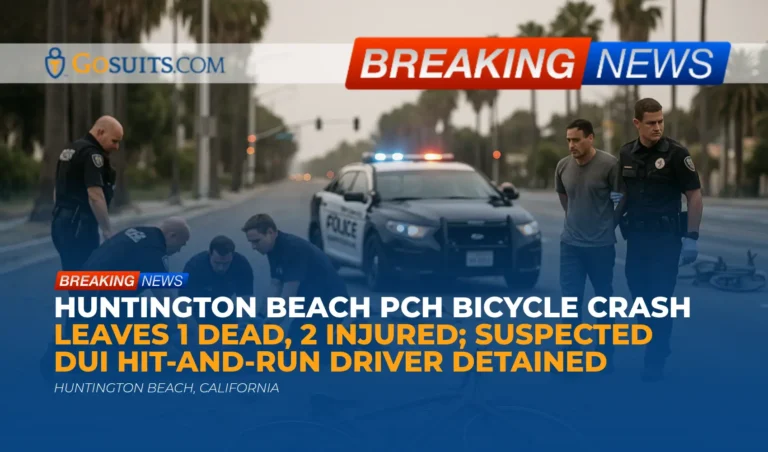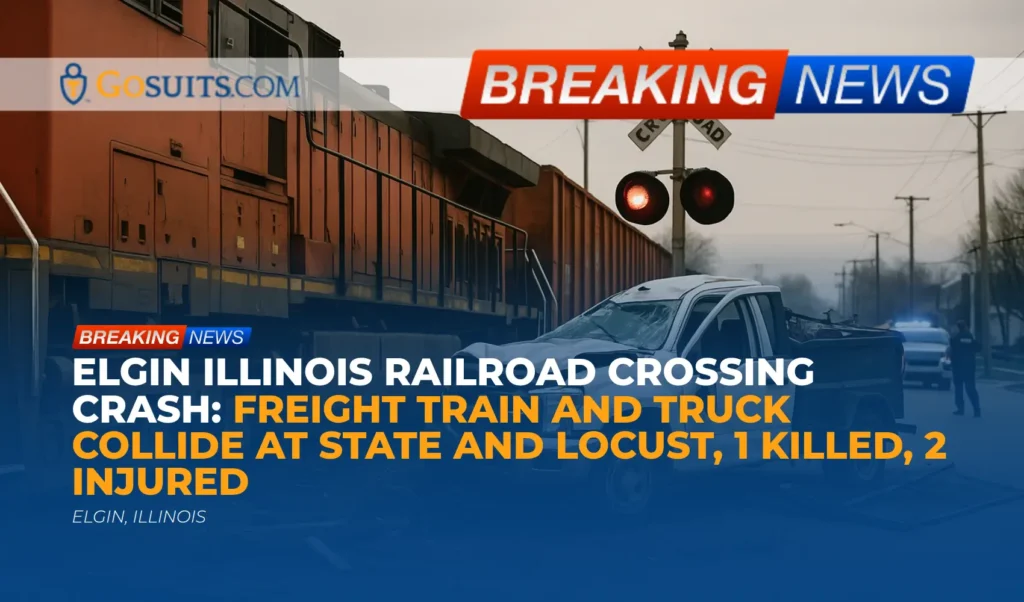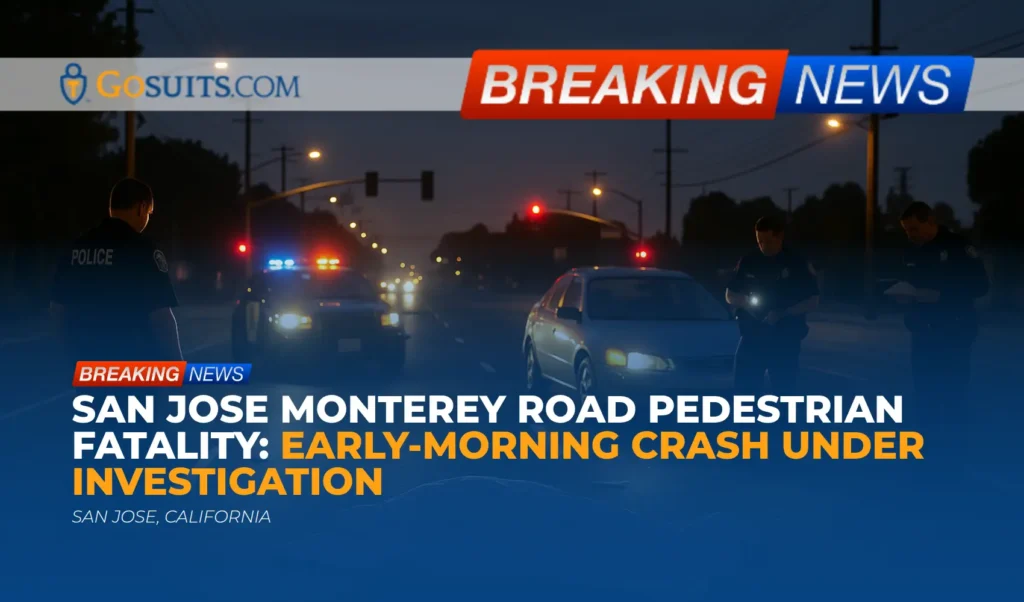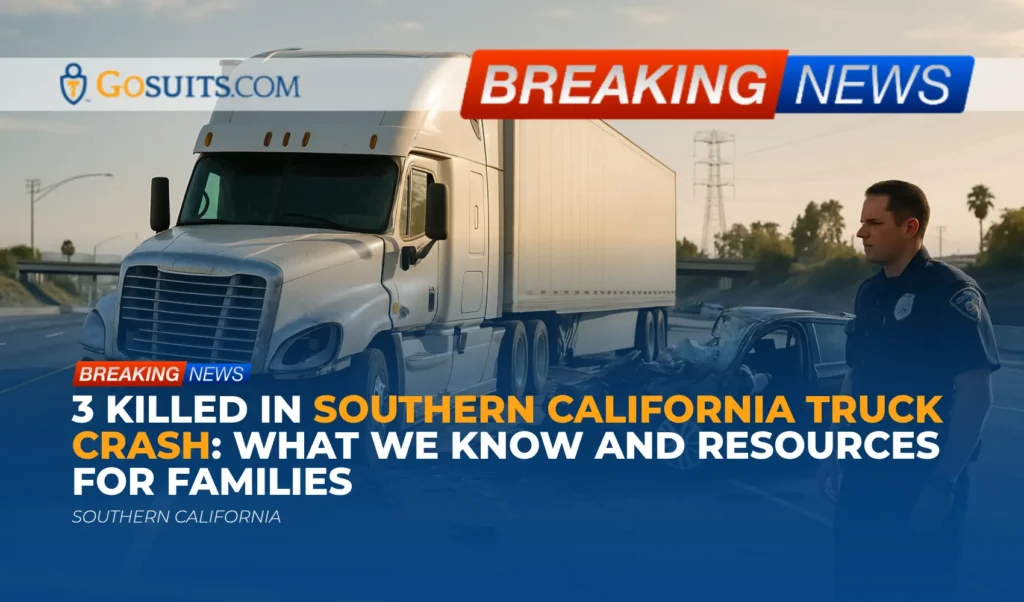- Overview of the Huntington Beach PCH bicycle crash
- What we know so far
- Active investigation and how witnesses can help
- Where to obtain official records and who to call
- Rights of injured cyclists and surviving families in California
- Potential civil liability and insurance issues after a DUI hit-and-run
- Key California laws that may apply
- Evidence to preserve right away
- Safety and prevention notes for the community
- Support and victim assistance resources
- Steps people commonly take after a serious bike crash
- Commentary from Gosuits Huntington Beach, California Personal Injury Attorney
- Why taking action matters now
Overview of the Huntington Beach PCH bicycle crash
A Monday morning collision along Pacific Coast Highway in Huntington Beach left one cyclist deceased and two others seriously injured, according to information released by local authorities. Police were called shortly after 6:45 a.m. to the area north of PCH and Newland Street. They located three adult male cyclists and badly damaged bicycles in or near the southbound lanes. One cyclist, identified by county officials as a 45-year-old man from Garden Grove, was pronounced deceased at the scene. Two others were transported to a nearby hospital with severe injuries.
Investigators report the involved vehicle was a gold 2006 Mercedes-Benz E-Class. The driver initially left the scene but stopped about one-half mile away, where officers detained the motorist. All southbound lanes between Beach Boulevard and Newland Street were temporarily closed for a reconstruction investigation and reopened before 1 p.m. Police have asked any witnesses to come forward.
This article is intended to help community members understand what happened, the typical steps to obtain official records, and general civil-law context for families and injured riders after serious roadway incidents.
What we know so far
Time and location
The collision occurred shortly after 6:45 a.m. on Pacific Coast Highway in Huntington Beach, near the intersection with Newland Street. The southbound lanes were affected during the investigation.
People involved
Authorities found three adult male cyclists at the scene. The Orange County Sheriff-Coroner, through an official spokesperson, identified the cyclist who died as a 45-year-old Garden Grove resident. Two other cyclists were hospitalized with significant injuries. Their names and conditions were not immediately available at the time of the police update.
Vehicle and driver
Police identified the involved vehicle as a gold 2006 Mercedes-Benz sedan. The driver was detained by responding officers approximately half a mile from the collision location and later booked on suspicion of gross vehicular manslaughter, felony hit-and-run, felony DUI, and possession of narcotics. Formal charging decisions in criminal court are separate from the ongoing civil investigation and any civil claims that may follow.
Initial road closures
All southbound lanes of PCH between Beach Boulevard and Newland Street were closed temporarily to allow for on-scene investigation by the police department’s specialized crash team. Lanes reopened before 1 p.m., according to the department.
Active investigation and how witnesses can help
Huntington Beach Police Department’s Multidisciplinary Accident Investigation Team (MAIT) is handling the crash investigation. MAIT teams typically gather and preserve evidence, document roadway conditions, analyze vehicle damage, and reconstruct movements to determine how a collision happened. They may seek video from nearby businesses and residences, vehicle event data recorder information, cell phone records where appropriate, and witness statements from motorists, cyclists, pedestrians, and first responders.
If anyone witnessed the collision or events leading to it, or has dashcam or security footage that may show the roadway, vehicle movements, or conditions that morning, police request contact at (714) 536-5670. Timely witness accounts and recordings can be crucial for accurate reconstruction.
Where to obtain official records and who to call
In the aftermath of a serious crash, families and injured people often need official documents for insurance, employment, and potential civil claims. The following are commonly requested records and where they typically come from. Processes can vary by agency and may require identification, proof of relationship, or legal authority.
Police traffic collision report (Huntington Beach Police Department)
A traffic collision report is typically prepared by the investigating officers and includes narrative details, diagrams, involved parties, and any preliminary findings. Processing and release times vary. To learn how to request a copy, visit the City of Huntington Beach Police Department’s official webpage: Huntington Beach Police Department. California’s public records framework is described by the Attorney General here: California Public Records Act overview.
Note: Collision reports are generally released to involved parties, their legal representatives, and insurers. Redactions may apply.
Coroner records and autopsy report (Orange County)
In Orange County, death investigations are conducted by the Sheriff-Coroner. Next of kin may request information about the investigation and, where available, certified copies of the autopsy report once complete. Visit the Orange County Sheriff-Coroner’s page for guidance: Orange County Sheriff-Coroner, Coroner Division.
Death certificate
Certified copies of death certificates are issued through vital records. Statewide guidance is available from the California Department of Public Health: CDPH Vital Records. Families may also obtain certificates through local county vital records offices once the record is registered.
Emergency medical records
Hospitals and EMS agencies maintain records of care provided. Authorized requesters can ask the treating hospital’s Health Information Management (HIM) or Medical Records department for records. HIPAA rules apply. Hospital websites typically list release-of-information procedures.
Witness information
If you have contact information for witnesses or video, provide it to Huntington Beach Police at (714) 536-5670. Witness coordination through the investigating agency helps ensure information is preserved in the official file.
Rights of injured cyclists and surviving families in California
California civil law provides avenues for those harmed by negligent driving to pursue accountability through personal injury or wrongful death claims. While every case is unique, the following general principles often apply.
Wrongful death and survival claims
– Wrongful death: Certain surviving family members may bring a civil wrongful death action seeking damages for losses such as financial support the decedent would have provided, funeral and burial expenses, and loss of companionship. See California Code of Civil Procedure 377.60: CCP 377.60.
– Survival action: The decedent’s estate may bring a survival claim for harms the person suffered between injury and death, among other allowable losses. See California Code of Civil Procedure sections 377.30 and 377.34: CCP 377.30 and CCP 377.34.

Statute of limitations
Most California personal injury and wrongful death civil actions have a two-year limitations period from the date of injury or death. See California Code of Civil Procedure 335.1: CCP 335.1. Exceptions can apply, but deadlines are strict.
Bicyclists’ rights on public roads
Bicyclists generally have the same rights and responsibilities as vehicle drivers on California roadways. California’s “Three Feet for Safety Act” requires motorists to provide at least three feet of clearance when passing a bicycle, when feasible. See California Vehicle Code 21760: CVC 21760.
Potential civil liability and insurance issues after a DUI hit-and-run
When a collision involves allegations of impaired driving or fleeing the scene, several civil-law concepts often come into play. The specifics always turn on the facts, the insurance policies involved, and the evidence gathered by investigators.
Negligence and negligence per se
A driver who violates safety statutes and causes harm may be found negligent. California Evidence Code 669 describes “negligence per se,” where breaking a statute designed to protect a class of people from a type of harm can create a presumption of negligence in a civil case if the violation caused the injury. See: Evidence Code 669. Alleged violations in DUI and hit-and-run contexts can be relevant to this analysis.
Insurance coverage layers
– Liability insurance of the at-fault driver: California updated minimum auto liability limits effective January 1, 2025, to $30,000 per person and $60,000 per occurrence for bodily injury and $15,000 for property damage (SB 1107). See the enrolled bill text: SB 1107. These are minimums; many policies carry higher limits.
– Uninsured/underinsured motorist (UM/UIM): California law provides for UM/UIM coverage in auto policies, which can extend to insured persons struck by a motor vehicle as pedestrians or cyclists, depending on policy terms. See Insurance Code 11580.2: Insurance Code 11580.2. Policy language matters greatly; consult the declarations page and endorsements.
– Medical payments (MedPay): Some policies include no-fault medical payments coverage that may reimburse medical expenses up to a set limit, regardless of fault. Availability and coordination with health insurance vary by policy.
Punitive damages considerations
California Civil Code 3294 allows punitive damages in civil cases where the plaintiff proves by clear and convincing evidence that the defendant acted with malice, oppression, or fraud. In some cases involving intoxicated driving, courts have allowed punitive damages, depending on the facts. See Civil Code 3294: Civil Code 3294.
Statements to insurers
Insurance adjusters may contact people soon after a crash for recorded statements. What is said can be used to evaluate and potentially limit a claim. It is generally prudent to speak with a qualified attorney before giving any detailed statement to any insurer, including your own.
Key California laws that may apply
– Driving under the influence: California Vehicle Code section 23152 prohibits driving under the influence of alcohol or drugs. See CVC 23152.
– Hit-and-run involving injury or death: California Vehicle Code section 20001 requires drivers involved in collisions resulting in injury or death to stop and fulfill specific duties. See CVC 20001.
– Three-foot passing law for bicyclists: California Vehicle Code section 21760 requires at least three feet of clearance, as noted above. See CVC 21760.
Evidence to preserve right away
Evidence disappears quickly after roadway incidents, especially on busy corridors like Pacific Coast Highway. Timely steps can help ensure the facts are documented accurately.
- Photographs and video: Preserve smartphone photos, dashcam footage, cycling computer data, and any surveillance clips. Back up files to multiple locations and note the exact date, time, and location.
- Witness information: Keep names, phone numbers, and emails for anyone who saw the crash, its lead-up, or the aftermath. Provide this information to the investigating agency.
- Physical evidence: Store damaged bicycle parts, helmets, clothing, lights, and accessories. Do not repair or discard items before they can be inspected.
- Medical documentation: Maintain hospital discharge papers, imaging, prescriptions, and bills. Ask providers for complete records when appropriate.
- Employment and financial records: Save pay stubs and employer statements reflecting time off, lost income, or accommodations.
- Roadway conditions: Note construction, debris, lighting, weather, and traffic signal status at the time of the incident.
- Police report information: Record the report number, investigating officers’ names, and contact details for follow-up.
Safety and prevention notes for the community
Alcohol-impaired driving remains a significant public safety challenge. Federal data show alcohol-impaired driving fatalities nationwide continue to account for a large share of traffic deaths. See the National Highway Traffic Safety Administration overview: NHTSA: Drunk Driving.
Bicyclist safety is a shared responsibility. California’s Office of Traffic Safety tracks trends and supports local safety efforts. For statewide bicyclist safety resources, see California OTS Bicycle Safety.
While most motorists and cyclists follow the rules, high-speed corridors like PCH demand extra caution, especially at dawn when visibility may be variable. Compliance with the three-foot passing rule, sober driving, attentive riding, and predictable lane positioning help reduce risk for everyone.
Support and victim assistance resources
Beyond medical care and legal processes, families and injured people may need practical and emotional support. Several public agencies provide information or assistance.
- Huntington Beach Police Department: For witness information, updates, or to provide video, call the number provided by HBPD for this investigation: (714) 536-5670. General department information: Huntington Beach Police Department.
- Orange County Sheriff-Coroner: For coroner case status and autopsy report procedures, visit: OC Sheriff-Coroner.
- California Department of Public Health: For statewide guidance on obtaining death certificates, see: CDPH Vital Records.
- California Victim Compensation Board (CalVCB): Provides financial assistance for eligible victims of violent crime and their families, including funeral/burial costs, medical and mental health services. Learn more at: CalVCB.
- NHTSA and CDC safety information: National resources on impaired driving and injury prevention are available from NHTSA and CDC: NHTSA: Drunk Driving and CDC: Impaired Driving.
Steps people commonly take after a serious bike crash
The period after a major collision can feel overwhelming. The following general steps help people stay organized and protect their options, while staying mindful of the ongoing law enforcement investigation.
- Prioritize medical care and follow-up: Seek immediate care, attend follow-up appointments, and follow medical guidance on recovery. Keep all records and receipts.
- Coordinate with investigators: Provide witness information, video, or photographs to HBPD. Document the case number and officers’ names for reference.
- Preserve evidence: Keep the bicycle, helmet, clothing, lights, and any accessories in their post-crash condition. Photograph everything before moving it.
- Keep a recovery journal: Note symptoms, pain levels, sleep disruptions, and mobility challenges. This can help healthcare providers and aid later documentation.
- Insurance notifications: Before speaking with any insurance adjuster in detail, it is generally wise to consult an attorney. Statements to insurers can be recorded and may be used to evaluate or limit a claim. After getting legal guidance, notify your own auto insurer if UM/UIM or MedPay could apply, and your health insurer for billing coordination.
- Track financial impacts: Save pay stubs, time-off records, out-of-pocket expenses, and receipts for household support needs during recovery.
- Seek support services: Explore CalVCB resources for eligible expenses and counseling. Lean on community networks, counseling, or grief support as needed.

Commentary from Gosuits Huntington Beach, California Personal Injury Attorney
Our hearts are with the cyclists, their families, and the Huntington Beach community. Crashes like this are devastating, and no words can truly capture that pain. The reflections below are offered for educational and general informational purposes, to help community members understand the civil-law context in the wake of such a loss.
Based on the details released by authorities, this event involved a group of cyclists traveling along PCH during the morning hours, with a collision severe enough to destroy bicycles and close the highway for an extended investigation. When an incident includes allegations of impaired driving and leaving the scene, the civil implications can be significant. California’s safety statutes exist to protect the public. When those rules are allegedly broken and people are hurt, civil law provides a path to accountability. A thorough MAIT investigation, witness statements, and any available camera footage will be key to understanding vehicle movement, speed, roadway conditions, and the sequence of impacts.
Insurance companies and large corporations often move quickly after serious collisions. Adjusters may request recorded statements and medical authorizations, sometimes before the facts are fully documented. These interactions are not neutral; they are part of a claims process designed to limit payouts. People unfamiliar with these tactics may unknowingly minimize their injuries, speculate about fault, or agree to releases that constrain their options later. That is why many choose to seek a free consultation with a seasoned attorney before speaking in depth with any insurer. A brief conversation can clarify rights, coordination of benefits, and practical next steps while the investigation unfolds.
In cases involving a fatality, the family’s role in the process can feel daunting amid grief. Experienced counsel can help align the civil investigation with the official police and coroner processes, identify all potential coverage sources, and preserve the evidence needed for a clear, fact-based presentation. Nothing can make a family whole after a loss, but informed decisions can protect their rights and honor their loved one’s story.
Why taking action matters now
– Preserve crucial evidence while it still exists: Physical debris is cleared, roadway conditions change, and camera footage is overwritten. Acting promptly helps ensure bike components, helmet damage, dashcam files, and business security clips are preserved and reviewed.
– Meet strict legal timelines: California’s general two-year statute for personal injury and wrongful death cases is a hard deadline. Some insurance notice requirements and benefits programs have far shorter timelines. Early attention prevents preventable deadline issues.
– Coordinate medical and financial documentation: The foundation of any claim is accurate medical and economic documentation. Early organization of records, bills, and lost income evidence reduces stress and avoids gaps.
– Understand insurance interactions before speaking on the record: Statements given to insurance adjusters can be recorded. Without clear guidance, people may unintentionally limit their claims. A free consultation can clarify what to say, what not to say, and how to route communications.
– Identify all potential coverage sources: Liability policies, UM/UIM, MedPay, and other benefits may be available. Locating and coordinating these sources early can make a meaningful difference in the aftermath of a serious crash.
– Support community safety efforts: Sharing witness information with investigators, and participating in community discussions about road safety, helps create a clearer picture of what happened and how similar tragedies can be reduced in the future.
Additional context and resources
– California Public Records Act overview: Attorney General’s CPRA page.
– Vital records guidance: CDPH Vital Records.
– OC Sheriff-Coroner: Coroner Division.
– Bicyclist safety and impaired driving education: California OTS and NHTSA.
– California civil codes and vehicle codes cited: California Legislative Information.






